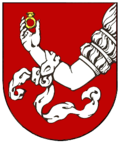This article has multiple issues. Please help improve it or discuss these issues on the talk page . (Learn how and when to remove these messages)
|
Duchy of Mecklenburg-Stargard | |||||||||
|---|---|---|---|---|---|---|---|---|---|
| 1352–1471 | |||||||||
 Mecklenburg c. 1230 (pink) | |||||||||
| Status |
| ||||||||
| Capital | Burg Stargard 53°29′N13°18′E / 53.483°N 13.300°E | ||||||||
| Government | Monarchy | ||||||||
| Duke | |||||||||
• 1352–1392/93 | John I, first | ||||||||
• 1466–1471 | Ulrich II, last | ||||||||
| History | |||||||||
• Established | 1352 | ||||||||
• Disestablished | 1471 | ||||||||
| |||||||||
| Today part of | Germany | ||||||||
The Duchy of Mecklenburg-Stargard, [a] also simply known as Mecklenburg-Stargard, and also as the Duchy of Stargard [b] was a feudal district duchy in Mecklenburg within the Holy Roman Empire. Its capital was Burg Stargard. It was ruled by the House of Mecklenburg. The state was formed in 1352 from part of the Duchy of Mecklenburg-Schwerin, and existed until 1471, when it was incorporated into the Duchy of Mecklenburg. [1]
Contents
The main part of the Duchy of Mecklenburg-Stargard comprised the Lordship of Stargard in what is now the state of Mecklenburg-Western Pomerania, an area in the border area between Brandenburg, Pomerania and Mecklenburg. The lordship was named after the medieval castle in Stargard. Smaller areas were Sternberg and the Eldenburg with the historic country Ture.
